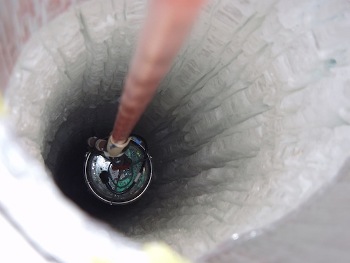May 17 2013
A massive telescope in the Antarctic ice reports the detection of 28 extremely high-energy neutrinos that might have their origin in cosmic sources. Two of these reached energies greater than 1 petaelectronvolt (PeV), an energy level thousands of times higher than the highest energy neutrino yet produced in a manmade accelerator.
 The massive IceCube telescope is comprised of more than 5,000 digital optical modules suspended in a cubic kilometer of ice at the South Pole. Photo: IceCube Collaboration/National Science Foundation
The massive IceCube telescope is comprised of more than 5,000 digital optical modules suspended in a cubic kilometer of ice at the South Pole. Photo: IceCube Collaboration/National Science Foundation
The IceCube Neutrino Observatory, run by an international collaboration and headquartered at the Wisconsin IceCube Particle Astrophysics Center (WIPAC) at the University of Wisconsin–Madison, identified the neutrinos, which were described today (May 15) in a talk at the IceCube Particle Astrophysics Symposium at UW–Madison.
“We’re looking for the first time at high energy neutrinos that are not coming from the atmosphere,” says Francis Halzen, principal investigator of IceCube and the Hilldale and Gregory Breit Distinguished Professor of Physics at UW–Madison. “This is what we were looking for,” he adds. “I would never have imagined that the science would be more exciting than building this instrument.”
Because they rarely interact with matter and are unimpeded by gravity, neutrinos can carry information about the workings of the highest-energy and most distant phenomena in the universe. Though billions of neutrinos pass through the Earth every second, the vast majority originate either in the sun or in the Earth’s atmosphere. Far rarer are high-energy neutrinos that may hail from the most powerful cosmic events — such as gamma ray bursts, black holes, or star formation — where they would be created in association with high-energy cosmic rays that can reach energies up to thousands of PeVs.
In his talk, postdoctoral fellow Nathan Whitehorn described 28 high-energy neutrino events captured by the detector between May 2010 and May 2012. These events, including two that exceeded the unprecedented energy level of 1 PeV, were one of the main goals for building a detector such as IceCube.
“Their properties are strongly inconsistent with what you would expect of atmospheric sources and are almost exactly what you would expect from an astrophysical source,” Whitehorn says.
It is premature to speculate where these neutrinos originated, he adds, but the IceCube collaboration is continuing to refine and expand the analysis.
IceCube is comprised of more than 5,000 digital optical modules suspended in a cubic kilometer of ice at the South Pole. The National Science Foundation-supported observatory detects neutrinos through the tiny flashes of blue light produced when a neutrino interacts with a water molecule in the ice.
The first hints of high-energy neutrinos came with the unexpected discovery in April 2012 of two detector events above 1 PeV. An analysis of those events was reported last month in a paper submitted to the journal Physical Review Letters. An intensified search, led by Whitehorn and fellow WIPAC scientists Claudio Kopper and Naoko Kurahashi Neilson, turned up 26 additional events exceeding 30 teraelectronvolts (TeV; one-thousandth of a PeV), which will be described in a forthcoming publication.
The IceCube Neutrino Observatory was built under a National Science Foundation (NSF) Major Research Equipment and Facilities Construction grant, with assistance from partner funding agencies around the world. The NSF Office of Polar Programs continues to support the project with a Maintenance and Operations grant. UW–Madison is the lead institution, and the international collaboration includes 250 physicists and engineers from the U.S., Germany, Sweden, Belgium, Switzerland, Japan, Canada, New Zealand, Australia and the U.K.